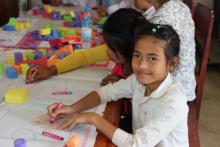Listening to and learning from every child
Noi attends school in Pakxeng district, in a mountainous area situated in Luang Prabang Province, Northern Laos. In Pakxeng, the cumulative effects of recurring small and moderate hazards (such as typhoons, fires, drought, landslides, floods) and the potential for devastating pandemics and infestations are ever-present threats. A remarkable number of these regularly recurring hazard impacts are considered only local disasters. Yet these events may affect hundreds of children for three days to one month, and sometimes occur several times a year. Classrooms, water sources and sanitation facilities are frequently damaged and out of use; access to schools is impossible or unsafe; and supplies and equipment may be damaged.
Disasters often have negative consequences on the education system including physical impacts on students and staff; physical impacts on school facilities; economic impacts that affect school enrolment; and psychological impacts on students and staff.
Noi is living with a disability and participated in an Australian Aid supported program that undertakes planning and assessment to reduce dangers in emergencies and disasters. Save the Children assists the most vulnerable including children with cognitive, physical and intellectual disabilities. Those who participate learn about hazards and community mapping through inclusive and accessible programming.
Last year while Noi’s parents were out working, a strong windstorm swept through her village destroying her house. Noi explains “I ran to my neighbour’s house…I was very scared”. She was scared of more damage from the wind and landslides. In Pakeng, heavy rains often trigger deadly debris slides (also known as landslides) due to the topography of the land and continued degradation of soil and deforestation.
She then spent 3 days at her neighbours’ house while the village helped to repair her damaged family home. When participating in the drawing of a hazard risk map of her village she says she “drew a house, school, trees and water”. She then marked the high risk areas with hazard icons including fire, landslide, and flood.
A government representative from the Ministry of Labour and Social Welfare expresses “Some children cannot hear, some cannot speak, but we were able to teacher them about disasters with new methods…it was important to learn this method”. He goes on to explain that “children don’t know about hazards and how to respond. If we teach this topic more they will be able to solve problems in the face of dangerous events. It is very important because children are the future of the country”
For International DRR Day in October 2013, Save the Children held National and Provincial events in partnership with the Ministry of Labour and Social Welfare displaying key message on DRR, Child Protection and the importance of inclusive development - keeping all children safe and protected from the impacts of hazards. In addition, Save the Children organised fun and engaging activities for children to undertake, including a drawing and reading activity, quizzes, and ran hazard drills teaching children about safe procedures. Children enjoyed learning about village safety and protection from hazards through inclusive, creative and innovative activities.
Julia Gemmel, Child Mental Health consultant says “When we disregard the needs of one, we are a not a community. For many reasons children with disabilities may be at greater risk during a disaster than their peers. However they are also the authority on their own capacity to participate in disaster risk reduction.”

Noi, 12 years old, at a hazard risk mapping session for children with disabilities
 Laos
Laos